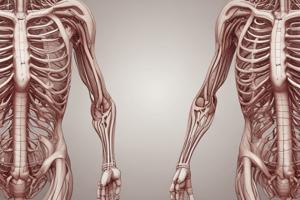Podcast
Questions and Answers
What are some symptoms that can result from conditions affecting the thoracic region?
What are some symptoms that can result from conditions affecting the thoracic region?
- Pain in the legs and feet
- Shoulder stiffness (correct)
- Cognitive impairment
- Nausea and vomiting
Which condition is NOT mentioned as a common cause of thoracic back pain?
Which condition is NOT mentioned as a common cause of thoracic back pain?
- Degenerative disc disease
- Pinched nerves
- Chronic fatigue syndrome (correct)
- Spinal curvature disorders
What are some treatment options for thoracic back pain?
What are some treatment options for thoracic back pain?
- Dietary supplements
- Meditation
- Acupuncture (correct)
- Chiropractic adjustments
Which symptom is NOT associated with thoracic nerve pain?
Which symptom is NOT associated with thoracic nerve pain?
What can severe cases of conditions affecting the thoracic region lead to?
What can severe cases of conditions affecting the thoracic region lead to?
What is the main function of the thoracic spine?
What is the main function of the thoracic spine?
How many pairs of ribs are found in the thoracic region?
How many pairs of ribs are found in the thoracic region?
What do the ribs in the thoracic region attach to on both sides?
What do the ribs in the thoracic region attach to on both sides?
Which vital organs are protected by the rib cage in the thoracic region?
Which vital organs are protected by the rib cage in the thoracic region?
What is the role of the muscles surrounding the rib cage in the thoracic region in respiration?
What is the role of the muscles surrounding the rib cage in the thoracic region in respiration?
How does the structure of ribs in the thoracic region vary throughout life?
How does the structure of ribs in the thoracic region vary throughout life?
Flashcards are hidden until you start studying
Study Notes
Anatomy of the Thoracic Region
The thoracic region, also known as the mid-back, is part of the spine located between the neck and lower back. It consists of 12 vertebrae and plays a crucial role in providing stability to the body. Each vertebra in the thoracic region is attached to a rib on both sides, which contributes to the formation of the rib cage, protecting vital organs such as the heart, lungs, liver, and more.
Structure and Functions
The thoracic region contains 12 pairs of ribs, which are connected to the sternum and the thoracic vertebrae. These ribs provide support and protection for our essential organs. The structure of these ribs varies between individuals and can change throughout life due to various factors like growth and aging.
The thoracic spine serves multiple purposes, including:
- Providing stability: By connecting each vertebra to a rib on both sides, the thoracic spine helps maintain the structural integrity of the entire back.
- Protecting vital organs: The rib cage formed by the ribs and sternum protects the heart, lungs, liver, and other internal organs from injury and damage.
The thoracic region also plays a significant role in respiration. The muscles surrounding the rib cage allow for expansion and contraction, facilitating the process of breathing.
Common Issues and Symptoms
Conditions affecting the thoracic region can lead to various symptoms, including:
- Chronic pain in the thoracic area
- Stiffness
- Limited range of motion
- Muscle spasms
- Thoracic nerve pain symptoms, such as tingling, numbness, burning sensations, and pins and needles
- Muscle weakness
- Stooped posture
- Referral of pain to other areas, such as the ribs, shoulder, arm, fingers, neck, and legs
- Changes in bladder or bowel function or incontinence (severe cases).
Some common causes of thoracic back pain include degenerative disc disease, arthritis or osteoporosis, compression fractures, muscle sprains or strains, spinal curvature disorders, pinched nerves, herniated discs, spinal stenosis, and diseases such as cancer. Treatment options for thoracic back pain depend on the underlying condition and may involve medication, bracing, hot and cold therapy, physical therapy, and surgery in some cases.
Studying That Suits You
Use AI to generate personalized quizzes and flashcards to suit your learning preferences.




